Exploring the Potential of Mnemonic Devices
VerifiedAdded on 2019/09/19
|17
|3297
|281
Report
AI Summary
The assignment content discusses various cognitive psychology concepts, including proactive control of proactive interference using the method of loci, working memory, levels of processing, depth of processing, and encoding strategies. It also touches on memory self-efficacy, memory metaphors, and the use of mnemonic devices like the method of loci to facilitate learning. The content draws from research studies and articles published in various journals, highlighting the importance of understanding cognitive processes for effective learning and memory.
Contribute Materials
Your contribution can guide someone’s learning journey. Share your
documents today.

7006313
Perceived Effects of
Memory Techniques
on the Amount of
Words Recalled
1
Perceived Effects of
Memory Techniques
on the Amount of
Words Recalled
1
Secure Best Marks with AI Grader
Need help grading? Try our AI Grader for instant feedback on your assignments.

7006313
Abstract:
The following research report attempted to compare the Method of Loci to a standard
rehearsal technique. The Method of Loci is a type of memory palace, involving a familiar
route and replacing words with images in that loci. The standard rehearsal technique is
simply remembering material by using repetition. The hypothesis is simply that; participants
are likely to recall more words, when using the Method of Loci, compared to the standard
rehearsal technique. A between-group experimental design was used. The sample consisted
of two hundred and twenty Psychology students from Coventry University. There were 176
females and 80 males. The mean age in years was 25.86. The findings highlighted that the
Method of Loci was more successful than the standard rehearsal technique. The findings
reveal that the Method of Loci can be a useful tool to use in the real-life setting. It can be
incorporated into the educational context, which can be used as a revision method to help
remember information.
2
Abstract:
The following research report attempted to compare the Method of Loci to a standard
rehearsal technique. The Method of Loci is a type of memory palace, involving a familiar
route and replacing words with images in that loci. The standard rehearsal technique is
simply remembering material by using repetition. The hypothesis is simply that; participants
are likely to recall more words, when using the Method of Loci, compared to the standard
rehearsal technique. A between-group experimental design was used. The sample consisted
of two hundred and twenty Psychology students from Coventry University. There were 176
females and 80 males. The mean age in years was 25.86. The findings highlighted that the
Method of Loci was more successful than the standard rehearsal technique. The findings
reveal that the Method of Loci can be a useful tool to use in the real-life setting. It can be
incorporated into the educational context, which can be used as a revision method to help
remember information.
2
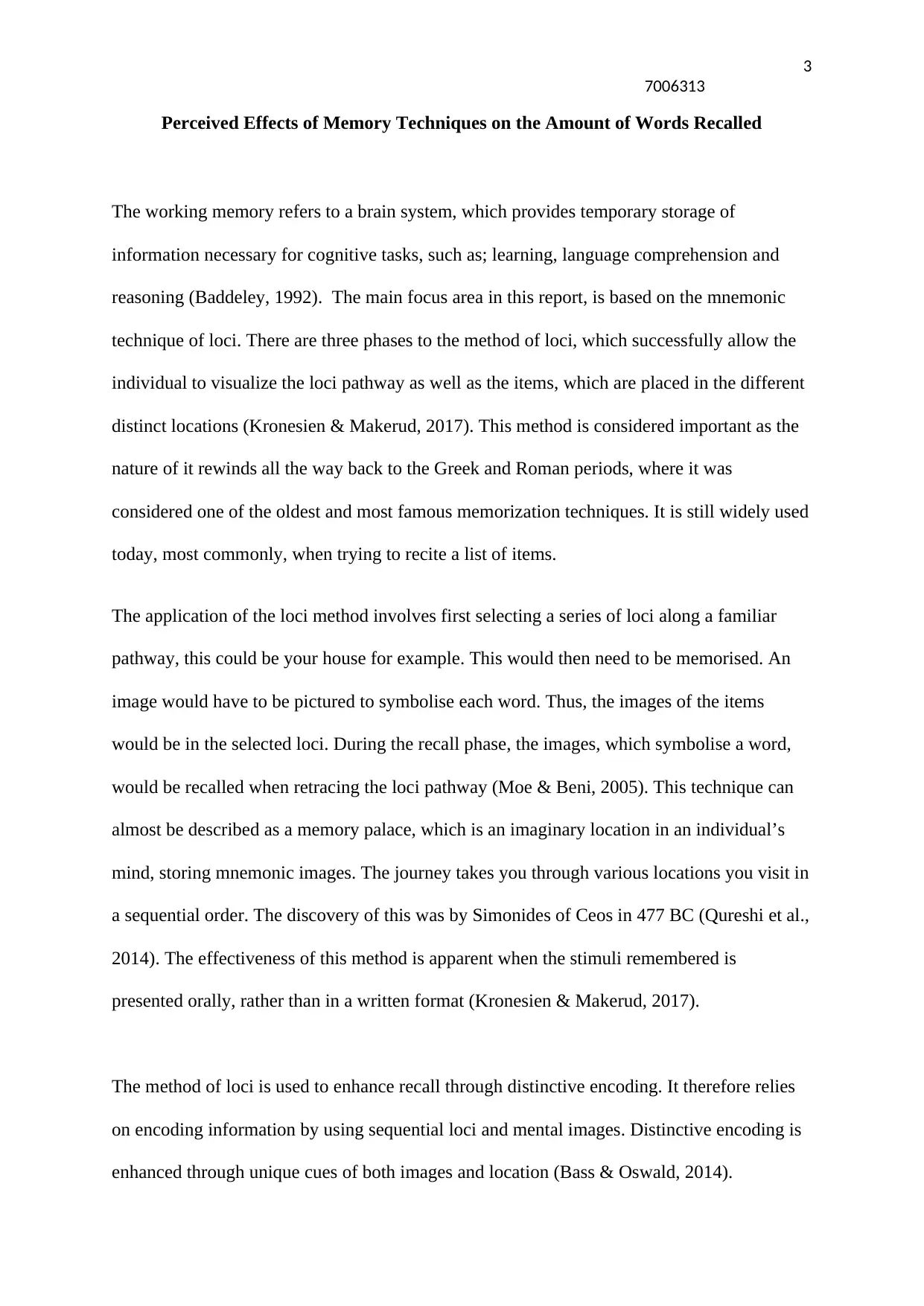
7006313
Perceived Effects of Memory Techniques on the Amount of Words Recalled
The working memory refers to a brain system, which provides temporary storage of
information necessary for cognitive tasks, such as; learning, language comprehension and
reasoning (Baddeley, 1992). The main focus area in this report, is based on the mnemonic
technique of loci. There are three phases to the method of loci, which successfully allow the
individual to visualize the loci pathway as well as the items, which are placed in the different
distinct locations (Kronesien & Makerud, 2017). This method is considered important as the
nature of it rewinds all the way back to the Greek and Roman periods, where it was
considered one of the oldest and most famous memorization techniques. It is still widely used
today, most commonly, when trying to recite a list of items.
The application of the loci method involves first selecting a series of loci along a familiar
pathway, this could be your house for example. This would then need to be memorised. An
image would have to be pictured to symbolise each word. Thus, the images of the items
would be in the selected loci. During the recall phase, the images, which symbolise a word,
would be recalled when retracing the loci pathway (Moe & Beni, 2005). This technique can
almost be described as a memory palace, which is an imaginary location in an individual’s
mind, storing mnemonic images. The journey takes you through various locations you visit in
a sequential order. The discovery of this was by Simonides of Ceos in 477 BC (Qureshi et al.,
2014). The effectiveness of this method is apparent when the stimuli remembered is
presented orally, rather than in a written format (Kronesien & Makerud, 2017).
The method of loci is used to enhance recall through distinctive encoding. It therefore relies
on encoding information by using sequential loci and mental images. Distinctive encoding is
enhanced through unique cues of both images and location (Bass & Oswald, 2014).
3
Perceived Effects of Memory Techniques on the Amount of Words Recalled
The working memory refers to a brain system, which provides temporary storage of
information necessary for cognitive tasks, such as; learning, language comprehension and
reasoning (Baddeley, 1992). The main focus area in this report, is based on the mnemonic
technique of loci. There are three phases to the method of loci, which successfully allow the
individual to visualize the loci pathway as well as the items, which are placed in the different
distinct locations (Kronesien & Makerud, 2017). This method is considered important as the
nature of it rewinds all the way back to the Greek and Roman periods, where it was
considered one of the oldest and most famous memorization techniques. It is still widely used
today, most commonly, when trying to recite a list of items.
The application of the loci method involves first selecting a series of loci along a familiar
pathway, this could be your house for example. This would then need to be memorised. An
image would have to be pictured to symbolise each word. Thus, the images of the items
would be in the selected loci. During the recall phase, the images, which symbolise a word,
would be recalled when retracing the loci pathway (Moe & Beni, 2005). This technique can
almost be described as a memory palace, which is an imaginary location in an individual’s
mind, storing mnemonic images. The journey takes you through various locations you visit in
a sequential order. The discovery of this was by Simonides of Ceos in 477 BC (Qureshi et al.,
2014). The effectiveness of this method is apparent when the stimuli remembered is
presented orally, rather than in a written format (Kronesien & Makerud, 2017).
The method of loci is used to enhance recall through distinctive encoding. It therefore relies
on encoding information by using sequential loci and mental images. Distinctive encoding is
enhanced through unique cues of both images and location (Bass & Oswald, 2014).
3

7006313
Roediger (1980) found that four mnemonic groups recalled a 20-word list better than the
control group. However, the method of loci and the peg word system were considered to be
more effective when the order of words remembered was important.
Standard rehearsal is a basic method which is used to memorise materials with the help of
repetition. Ahour & Berenji (2015) observed the effects of using rehearsal methods in
comparison with the method of loci. The findings indicate that learners using the loci method
were more successful in recalling words than learners applying rehearsal methods. These
results have been consistent with past research as it has been found that the loci method
improves and enhances vocabulary learning and retention (Moe & De Beni, 2005).
Craik & Lockhart (1972) invented the Levels of Processing theory. They argued that stimulus
information is processed at multiple levels, depending on characteristics, attention and
meaningfulness. Thus, new information will not have to enter in a sequential order. In
addition to this, information does not have to pass through a prescribed channel. If
information processing increases, then the amount an individual will remember, increases
accordingly. For example, information involving visual images or knowledge which is known
will be processed quicker. (Lutz & Huitt, 2003).
Shallow processing results to a fragile memory, leading to an increase chance of forgetting
information. Deep processing, on the other hand, leads to a higher chance of remembering.
Craik & Tulving (1975) observed the difference between deep and shallow processing.
Results showed that participants recalled more words semantically, than phonemically. The
theory itself has useful application as the use of deeper processing can increase memory
recall. This is evident in the method of loci, when trying to memorise a list of items.
4
Roediger (1980) found that four mnemonic groups recalled a 20-word list better than the
control group. However, the method of loci and the peg word system were considered to be
more effective when the order of words remembered was important.
Standard rehearsal is a basic method which is used to memorise materials with the help of
repetition. Ahour & Berenji (2015) observed the effects of using rehearsal methods in
comparison with the method of loci. The findings indicate that learners using the loci method
were more successful in recalling words than learners applying rehearsal methods. These
results have been consistent with past research as it has been found that the loci method
improves and enhances vocabulary learning and retention (Moe & De Beni, 2005).
Craik & Lockhart (1972) invented the Levels of Processing theory. They argued that stimulus
information is processed at multiple levels, depending on characteristics, attention and
meaningfulness. Thus, new information will not have to enter in a sequential order. In
addition to this, information does not have to pass through a prescribed channel. If
information processing increases, then the amount an individual will remember, increases
accordingly. For example, information involving visual images or knowledge which is known
will be processed quicker. (Lutz & Huitt, 2003).
Shallow processing results to a fragile memory, leading to an increase chance of forgetting
information. Deep processing, on the other hand, leads to a higher chance of remembering.
Craik & Tulving (1975) observed the difference between deep and shallow processing.
Results showed that participants recalled more words semantically, than phonemically. The
theory itself has useful application as the use of deeper processing can increase memory
recall. This is evident in the method of loci, when trying to memorise a list of items.
4
Secure Best Marks with AI Grader
Need help grading? Try our AI Grader for instant feedback on your assignments.
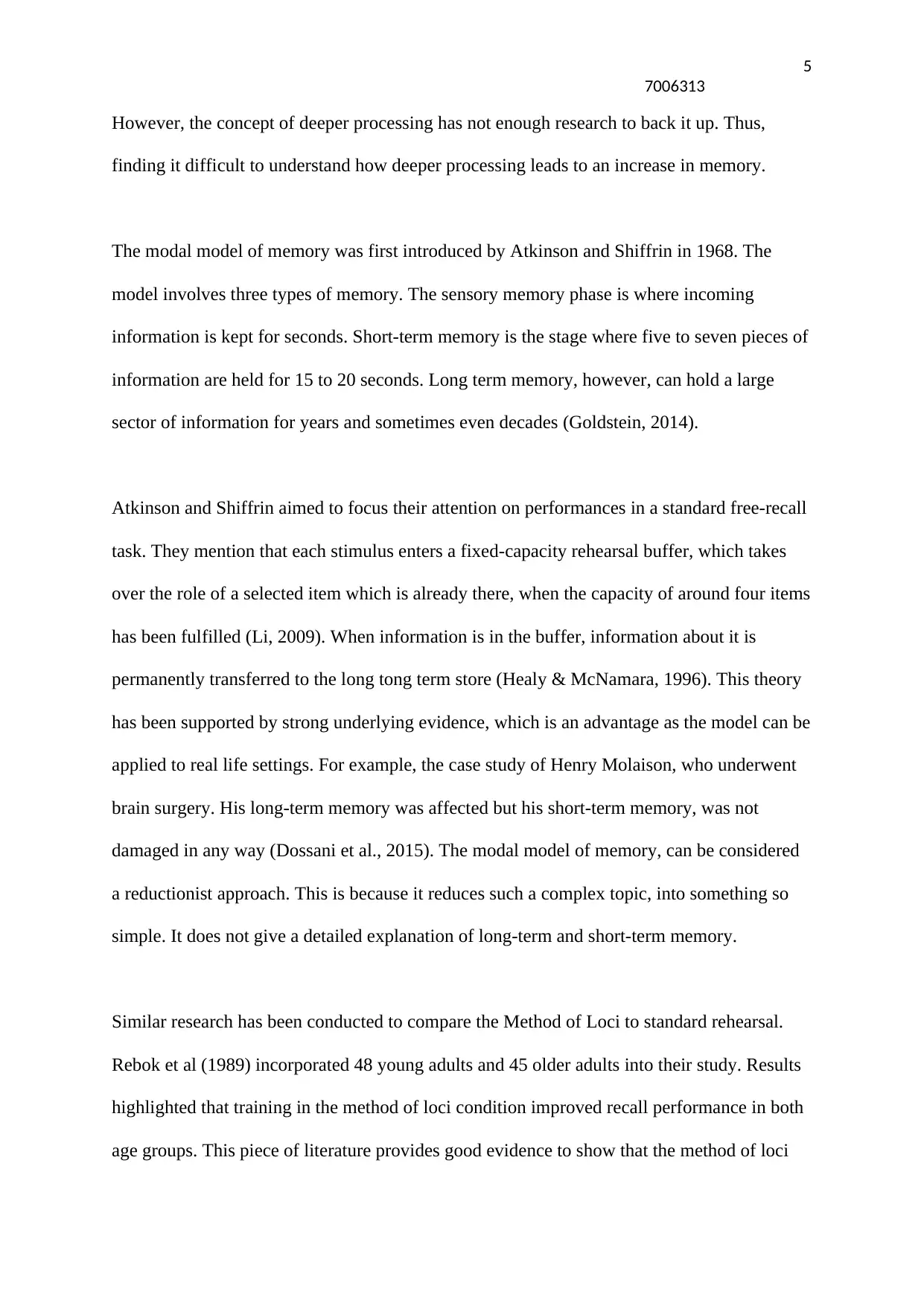
7006313
However, the concept of deeper processing has not enough research to back it up. Thus,
finding it difficult to understand how deeper processing leads to an increase in memory.
The modal model of memory was first introduced by Atkinson and Shiffrin in 1968. The
model involves three types of memory. The sensory memory phase is where incoming
information is kept for seconds. Short-term memory is the stage where five to seven pieces of
information are held for 15 to 20 seconds. Long term memory, however, can hold a large
sector of information for years and sometimes even decades (Goldstein, 2014).
Atkinson and Shiffrin aimed to focus their attention on performances in a standard free-recall
task. They mention that each stimulus enters a fixed-capacity rehearsal buffer, which takes
over the role of a selected item which is already there, when the capacity of around four items
has been fulfilled (Li, 2009). When information is in the buffer, information about it is
permanently transferred to the long tong term store (Healy & McNamara, 1996). This theory
has been supported by strong underlying evidence, which is an advantage as the model can be
applied to real life settings. For example, the case study of Henry Molaison, who underwent
brain surgery. His long-term memory was affected but his short-term memory, was not
damaged in any way (Dossani et al., 2015). The modal model of memory, can be considered
a reductionist approach. This is because it reduces such a complex topic, into something so
simple. It does not give a detailed explanation of long-term and short-term memory.
Similar research has been conducted to compare the Method of Loci to standard rehearsal.
Rebok et al (1989) incorporated 48 young adults and 45 older adults into their study. Results
highlighted that training in the method of loci condition improved recall performance in both
age groups. This piece of literature provides good evidence to show that the method of loci
5
However, the concept of deeper processing has not enough research to back it up. Thus,
finding it difficult to understand how deeper processing leads to an increase in memory.
The modal model of memory was first introduced by Atkinson and Shiffrin in 1968. The
model involves three types of memory. The sensory memory phase is where incoming
information is kept for seconds. Short-term memory is the stage where five to seven pieces of
information are held for 15 to 20 seconds. Long term memory, however, can hold a large
sector of information for years and sometimes even decades (Goldstein, 2014).
Atkinson and Shiffrin aimed to focus their attention on performances in a standard free-recall
task. They mention that each stimulus enters a fixed-capacity rehearsal buffer, which takes
over the role of a selected item which is already there, when the capacity of around four items
has been fulfilled (Li, 2009). When information is in the buffer, information about it is
permanently transferred to the long tong term store (Healy & McNamara, 1996). This theory
has been supported by strong underlying evidence, which is an advantage as the model can be
applied to real life settings. For example, the case study of Henry Molaison, who underwent
brain surgery. His long-term memory was affected but his short-term memory, was not
damaged in any way (Dossani et al., 2015). The modal model of memory, can be considered
a reductionist approach. This is because it reduces such a complex topic, into something so
simple. It does not give a detailed explanation of long-term and short-term memory.
Similar research has been conducted to compare the Method of Loci to standard rehearsal.
Rebok et al (1989) incorporated 48 young adults and 45 older adults into their study. Results
highlighted that training in the method of loci condition improved recall performance in both
age groups. This piece of literature provides good evidence to show that the method of loci
5
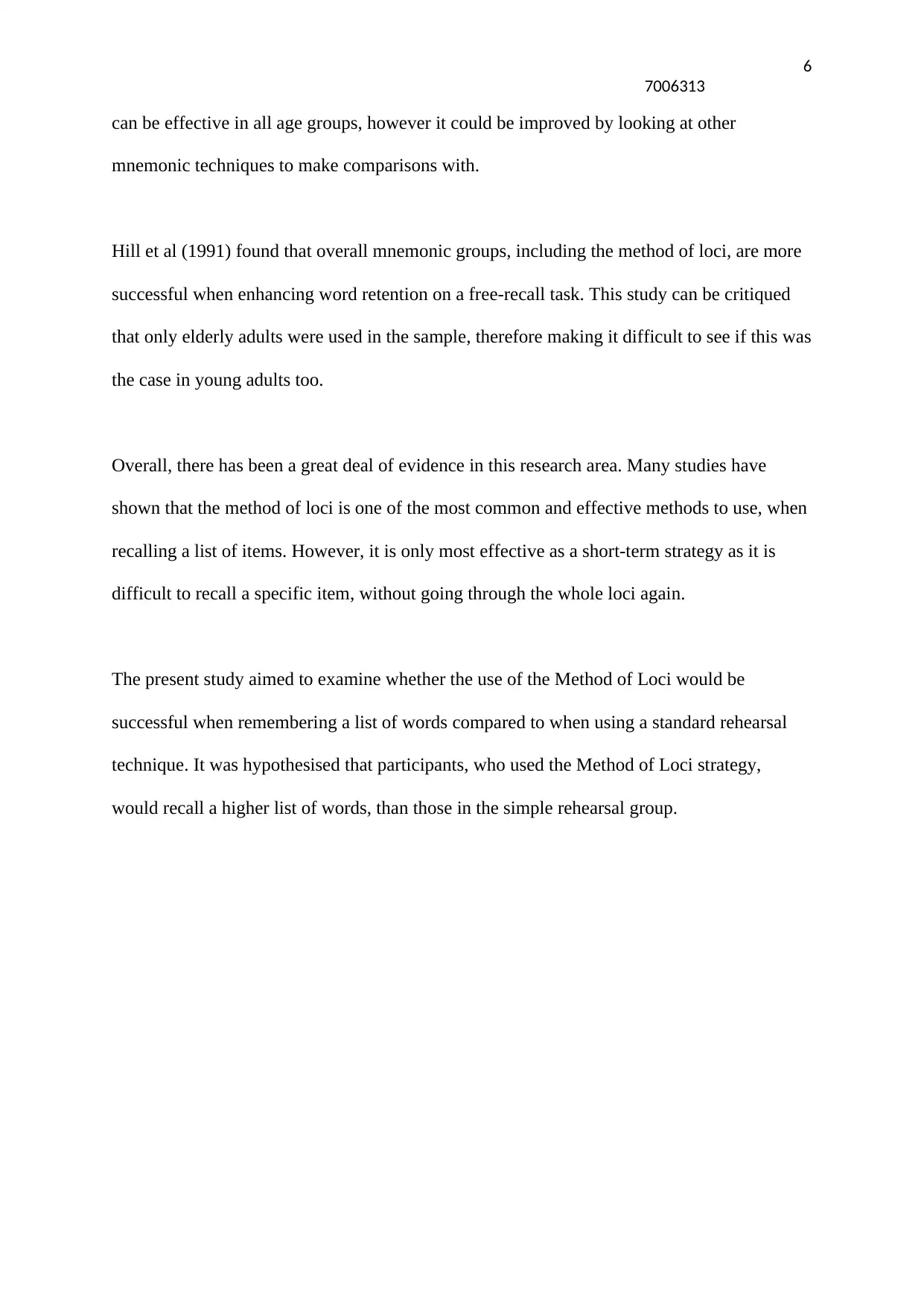
7006313
can be effective in all age groups, however it could be improved by looking at other
mnemonic techniques to make comparisons with.
Hill et al (1991) found that overall mnemonic groups, including the method of loci, are more
successful when enhancing word retention on a free-recall task. This study can be critiqued
that only elderly adults were used in the sample, therefore making it difficult to see if this was
the case in young adults too.
Overall, there has been a great deal of evidence in this research area. Many studies have
shown that the method of loci is one of the most common and effective methods to use, when
recalling a list of items. However, it is only most effective as a short-term strategy as it is
difficult to recall a specific item, without going through the whole loci again.
The present study aimed to examine whether the use of the Method of Loci would be
successful when remembering a list of words compared to when using a standard rehearsal
technique. It was hypothesised that participants, who used the Method of Loci strategy,
would recall a higher list of words, than those in the simple rehearsal group.
6
can be effective in all age groups, however it could be improved by looking at other
mnemonic techniques to make comparisons with.
Hill et al (1991) found that overall mnemonic groups, including the method of loci, are more
successful when enhancing word retention on a free-recall task. This study can be critiqued
that only elderly adults were used in the sample, therefore making it difficult to see if this was
the case in young adults too.
Overall, there has been a great deal of evidence in this research area. Many studies have
shown that the method of loci is one of the most common and effective methods to use, when
recalling a list of items. However, it is only most effective as a short-term strategy as it is
difficult to recall a specific item, without going through the whole loci again.
The present study aimed to examine whether the use of the Method of Loci would be
successful when remembering a list of words compared to when using a standard rehearsal
technique. It was hypothesised that participants, who used the Method of Loci strategy,
would recall a higher list of words, than those in the simple rehearsal group.
6

7006313
Aim and Hypothesis:
As sophisticated as memory is and as well as it serves us it is far from perfect, therefore, the
way that we encode information for retrieval and incorporate memory techniques is one way
in which we may be able to improve memory. The current research aimed to test as to
whether using the method of loci memorising technique enables for a better level of recall
compared to a standardised rehearsal of information memorising technique. An experimental
design was used to as to which technique was the most beneficial in the correct recall of a
series of words. Based on previous research literature (Kroneisen & Makerud 2017), it was
hypothesised that participants using the method of loci memorising strategy would recall
significantly more correct words than participants using a simple rehearsal strategy.
7
Aim and Hypothesis:
As sophisticated as memory is and as well as it serves us it is far from perfect, therefore, the
way that we encode information for retrieval and incorporate memory techniques is one way
in which we may be able to improve memory. The current research aimed to test as to
whether using the method of loci memorising technique enables for a better level of recall
compared to a standardised rehearsal of information memorising technique. An experimental
design was used to as to which technique was the most beneficial in the correct recall of a
series of words. Based on previous research literature (Kroneisen & Makerud 2017), it was
hypothesised that participants using the method of loci memorising strategy would recall
significantly more correct words than participants using a simple rehearsal strategy.
7
Paraphrase This Document
Need a fresh take? Get an instant paraphrase of this document with our AI Paraphraser

7006313
Methods
Design
A between-group experimental design was incorporated to study the effect of memory
technique (method of loci vs. standard rehearsal) on the ability to correctly recall words.
Participants were randomly allocated to either Condition A (method of loci) or Condition B
(standard rehearsal), where they were provided with instructions as to how they should
memorise a list of words. The study controlled for noise by requesting silence in the room
where memorisation and testing took part, additionally a scripted procedure ensured that data
collection was consistent for all researchers across the study.
Participants
Two hundred and twenty psychology students from Coventry University (UK) were recruited to
participate in the study using opportunity sampling. Students participated in exchange for course
credits. There were 176 females and 80 males (4 participants wished to withhold their gender) with a
mean age of 25.86 years (SD= 10.41) ranging from 18 to 56 years old. Ethical approval for this study
was granted by Faculty of Health Sciences at Coventry University.
8
Methods
Design
A between-group experimental design was incorporated to study the effect of memory
technique (method of loci vs. standard rehearsal) on the ability to correctly recall words.
Participants were randomly allocated to either Condition A (method of loci) or Condition B
(standard rehearsal), where they were provided with instructions as to how they should
memorise a list of words. The study controlled for noise by requesting silence in the room
where memorisation and testing took part, additionally a scripted procedure ensured that data
collection was consistent for all researchers across the study.
Participants
Two hundred and twenty psychology students from Coventry University (UK) were recruited to
participate in the study using opportunity sampling. Students participated in exchange for course
credits. There were 176 females and 80 males (4 participants wished to withhold their gender) with a
mean age of 25.86 years (SD= 10.41) ranging from 18 to 56 years old. Ethical approval for this study
was granted by Faculty of Health Sciences at Coventry University.
8
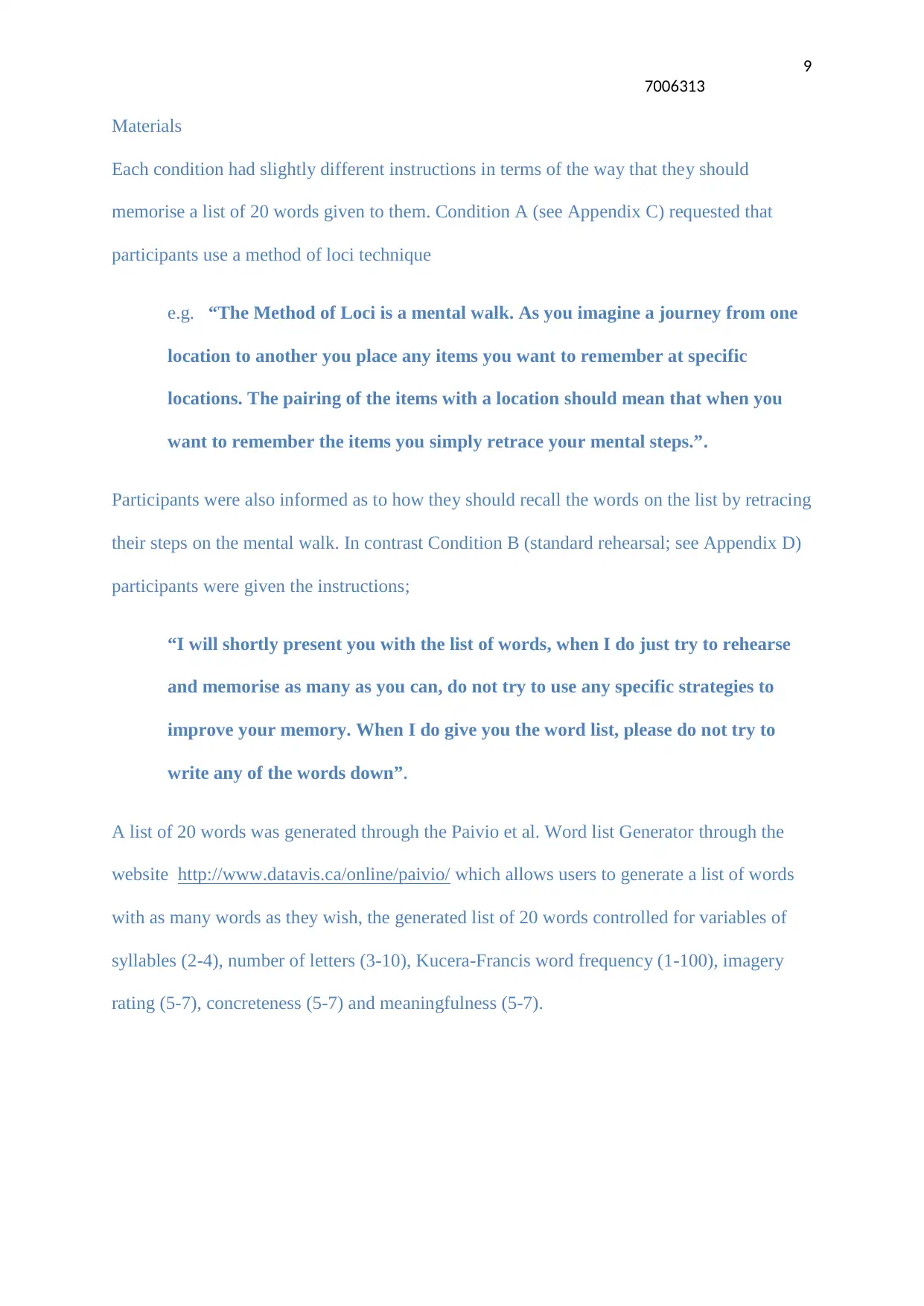
7006313
Materials
Each condition had slightly different instructions in terms of the way that they should
memorise a list of 20 words given to them. Condition A (see Appendix C) requested that
participants use a method of loci technique
e.g. “The Method of Loci is a mental walk. As you imagine a journey from one
location to another you place any items you want to remember at specific
locations. The pairing of the items with a location should mean that when you
want to remember the items you simply retrace your mental steps.”.
Participants were also informed as to how they should recall the words on the list by retracing
their steps on the mental walk. In contrast Condition B (standard rehearsal; see Appendix D)
participants were given the instructions;
“I will shortly present you with the list of words, when I do just try to rehearse
and memorise as many as you can, do not try to use any specific strategies to
improve your memory. When I do give you the word list, please do not try to
write any of the words down”.
A list of 20 words was generated through the Paivio et al. Word list Generator through the
website http://www.datavis.ca/online/paivio/ which allows users to generate a list of words
with as many words as they wish, the generated list of 20 words controlled for variables of
syllables (2-4), number of letters (3-10), Kucera-Francis word frequency (1-100), imagery
rating (5-7), concreteness (5-7) and meaningfulness (5-7).
9
Materials
Each condition had slightly different instructions in terms of the way that they should
memorise a list of 20 words given to them. Condition A (see Appendix C) requested that
participants use a method of loci technique
e.g. “The Method of Loci is a mental walk. As you imagine a journey from one
location to another you place any items you want to remember at specific
locations. The pairing of the items with a location should mean that when you
want to remember the items you simply retrace your mental steps.”.
Participants were also informed as to how they should recall the words on the list by retracing
their steps on the mental walk. In contrast Condition B (standard rehearsal; see Appendix D)
participants were given the instructions;
“I will shortly present you with the list of words, when I do just try to rehearse
and memorise as many as you can, do not try to use any specific strategies to
improve your memory. When I do give you the word list, please do not try to
write any of the words down”.
A list of 20 words was generated through the Paivio et al. Word list Generator through the
website http://www.datavis.ca/online/paivio/ which allows users to generate a list of words
with as many words as they wish, the generated list of 20 words controlled for variables of
syllables (2-4), number of letters (3-10), Kucera-Francis word frequency (1-100), imagery
rating (5-7), concreteness (5-7) and meaningfulness (5-7).
9
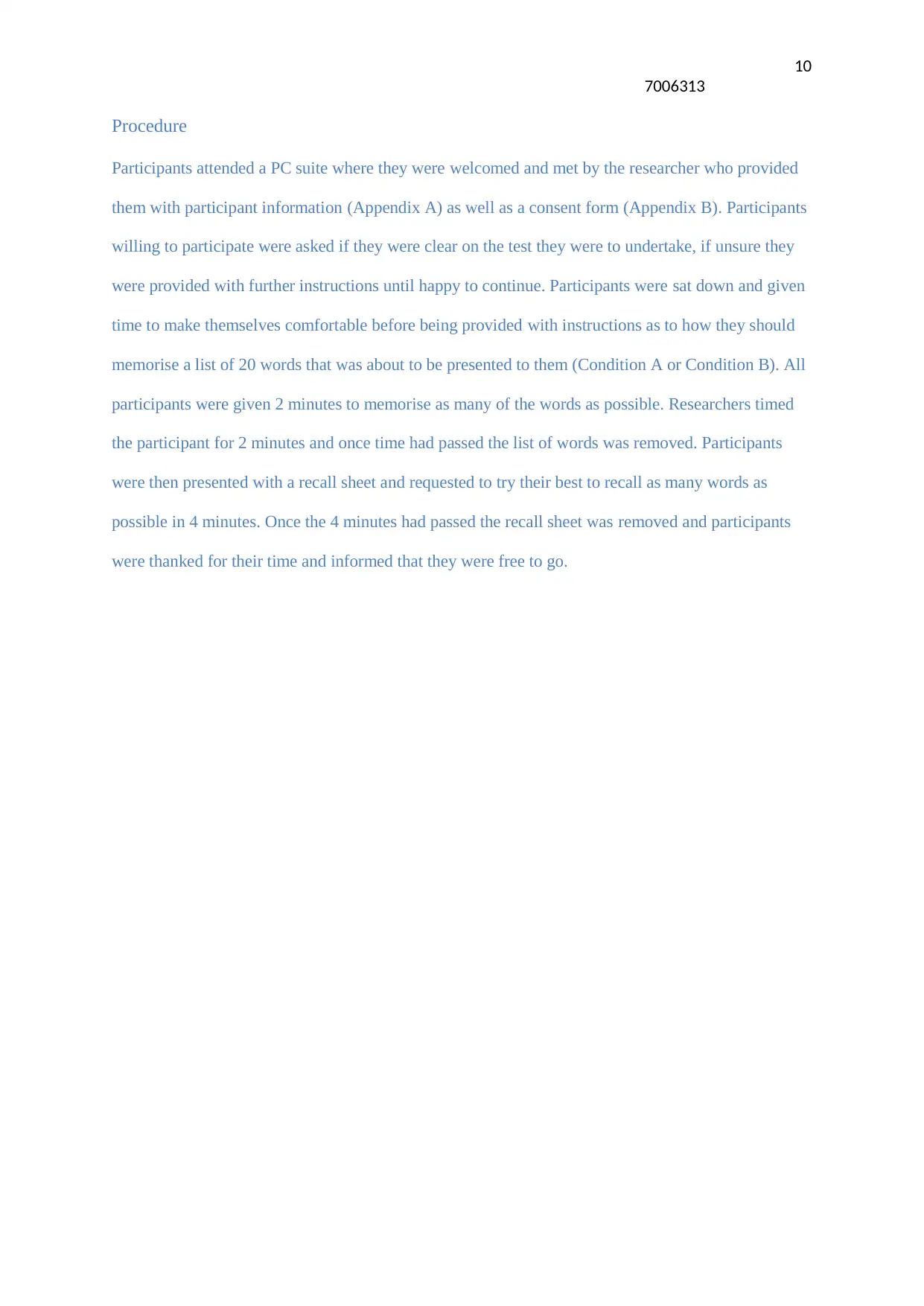
7006313
Procedure
Participants attended a PC suite where they were welcomed and met by the researcher who provided
them with participant information (Appendix A) as well as a consent form (Appendix B). Participants
willing to participate were asked if they were clear on the test they were to undertake, if unsure they
were provided with further instructions until happy to continue. Participants were sat down and given
time to make themselves comfortable before being provided with instructions as to how they should
memorise a list of 20 words that was about to be presented to them (Condition A or Condition B). All
participants were given 2 minutes to memorise as many of the words as possible. Researchers timed
the participant for 2 minutes and once time had passed the list of words was removed. Participants
were then presented with a recall sheet and requested to try their best to recall as many words as
possible in 4 minutes. Once the 4 minutes had passed the recall sheet was removed and participants
were thanked for their time and informed that they were free to go.
10
Procedure
Participants attended a PC suite where they were welcomed and met by the researcher who provided
them with participant information (Appendix A) as well as a consent form (Appendix B). Participants
willing to participate were asked if they were clear on the test they were to undertake, if unsure they
were provided with further instructions until happy to continue. Participants were sat down and given
time to make themselves comfortable before being provided with instructions as to how they should
memorise a list of 20 words that was about to be presented to them (Condition A or Condition B). All
participants were given 2 minutes to memorise as many of the words as possible. Researchers timed
the participant for 2 minutes and once time had passed the list of words was removed. Participants
were then presented with a recall sheet and requested to try their best to recall as many words as
possible in 4 minutes. Once the 4 minutes had passed the recall sheet was removed and participants
were thanked for their time and informed that they were free to go.
10
Secure Best Marks with AI Grader
Need help grading? Try our AI Grader for instant feedback on your assignments.
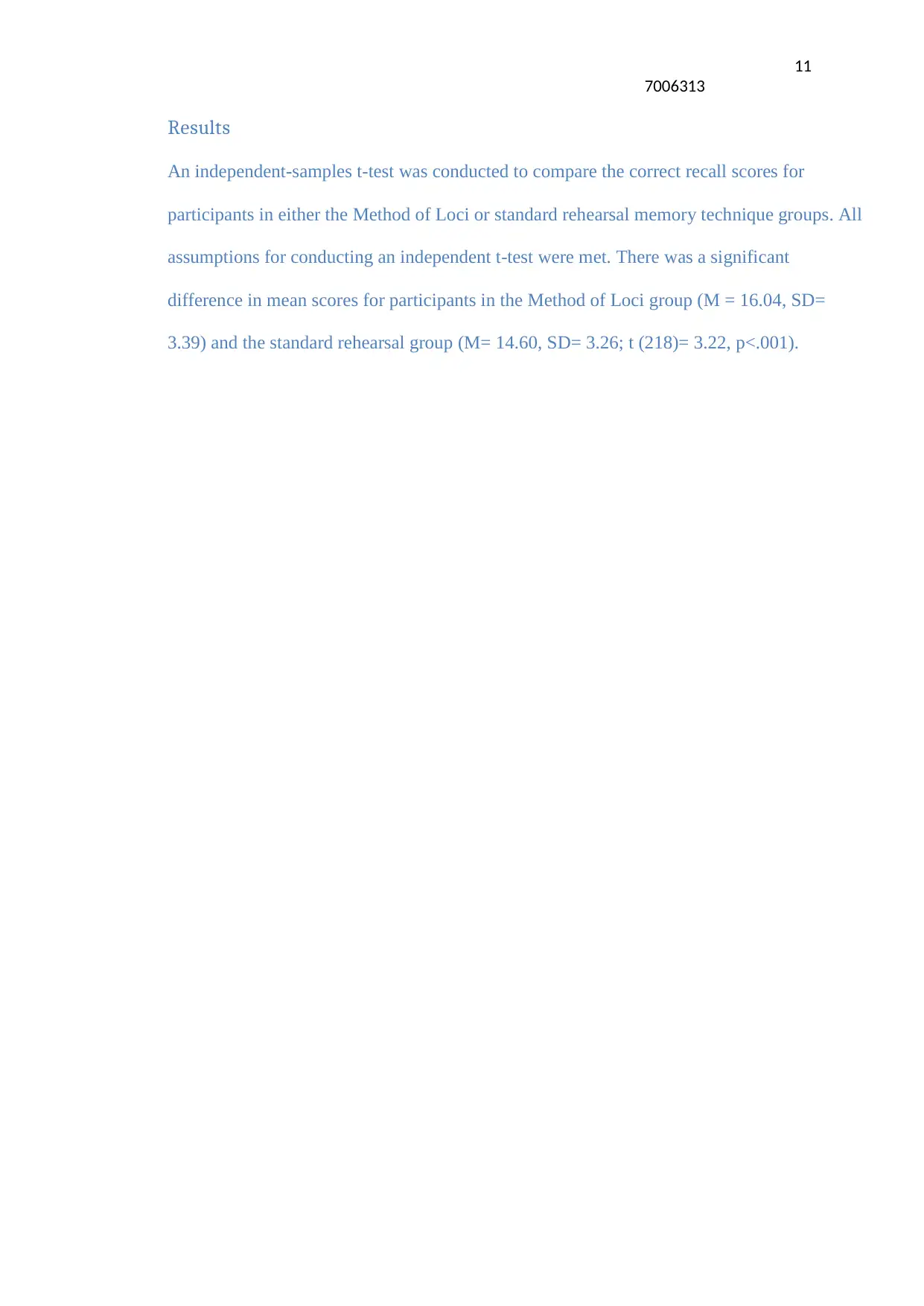
7006313
Results
An independent-samples t-test was conducted to compare the correct recall scores for
participants in either the Method of Loci or standard rehearsal memory technique groups. All
assumptions for conducting an independent t-test were met. There was a significant
difference in mean scores for participants in the Method of Loci group (M = 16.04, SD=
3.39) and the standard rehearsal group (M= 14.60, SD= 3.26; t (218)= 3.22, p<.001).
11
Results
An independent-samples t-test was conducted to compare the correct recall scores for
participants in either the Method of Loci or standard rehearsal memory technique groups. All
assumptions for conducting an independent t-test were met. There was a significant
difference in mean scores for participants in the Method of Loci group (M = 16.04, SD=
3.39) and the standard rehearsal group (M= 14.60, SD= 3.26; t (218)= 3.22, p<.001).
11
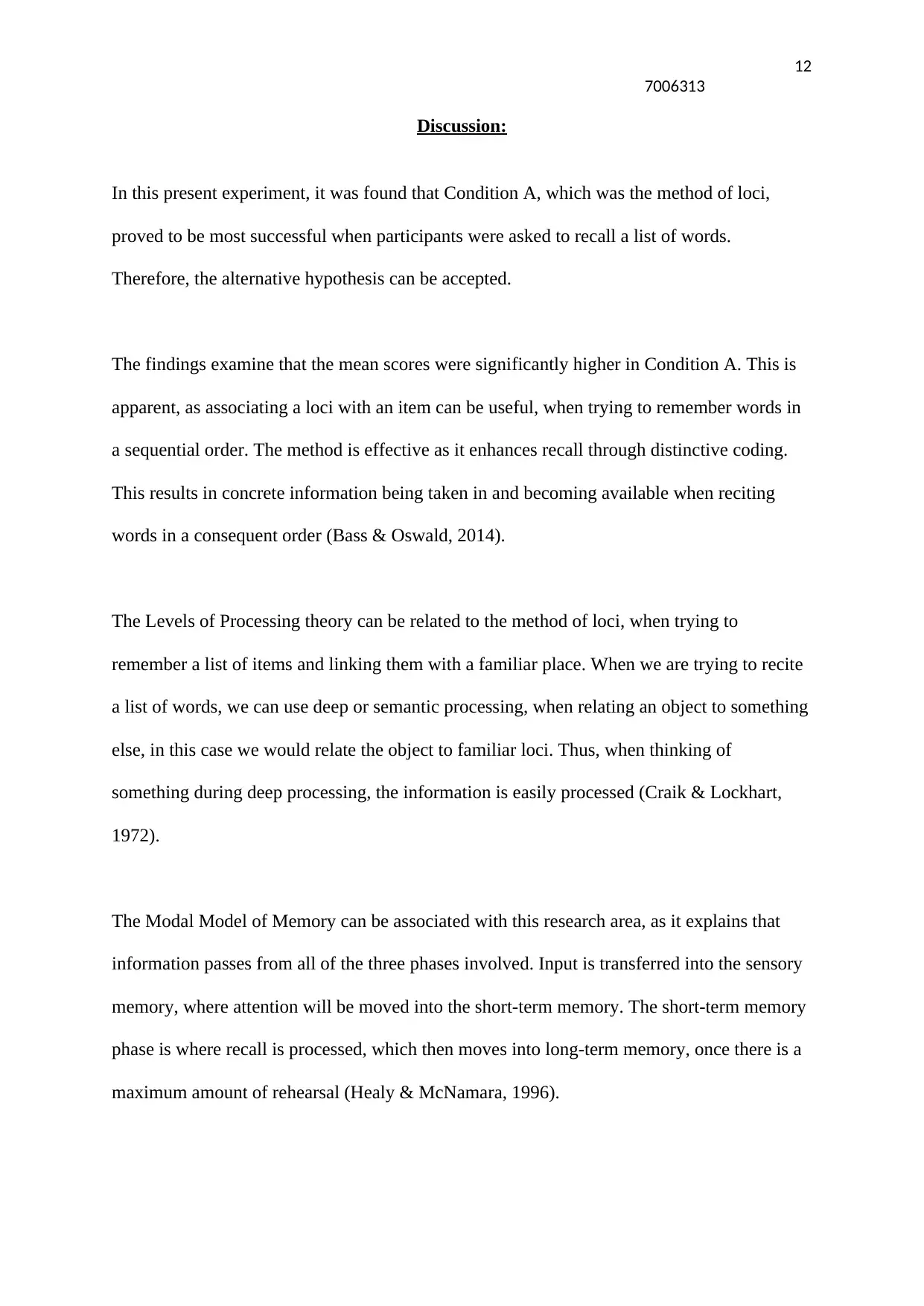
7006313
Discussion:
In this present experiment, it was found that Condition A, which was the method of loci,
proved to be most successful when participants were asked to recall a list of words.
Therefore, the alternative hypothesis can be accepted.
The findings examine that the mean scores were significantly higher in Condition A. This is
apparent, as associating a loci with an item can be useful, when trying to remember words in
a sequential order. The method is effective as it enhances recall through distinctive coding.
This results in concrete information being taken in and becoming available when reciting
words in a consequent order (Bass & Oswald, 2014).
The Levels of Processing theory can be related to the method of loci, when trying to
remember a list of items and linking them with a familiar place. When we are trying to recite
a list of words, we can use deep or semantic processing, when relating an object to something
else, in this case we would relate the object to familiar loci. Thus, when thinking of
something during deep processing, the information is easily processed (Craik & Lockhart,
1972).
The Modal Model of Memory can be associated with this research area, as it explains that
information passes from all of the three phases involved. Input is transferred into the sensory
memory, where attention will be moved into the short-term memory. The short-term memory
phase is where recall is processed, which then moves into long-term memory, once there is a
maximum amount of rehearsal (Healy & McNamara, 1996).
12
Discussion:
In this present experiment, it was found that Condition A, which was the method of loci,
proved to be most successful when participants were asked to recall a list of words.
Therefore, the alternative hypothesis can be accepted.
The findings examine that the mean scores were significantly higher in Condition A. This is
apparent, as associating a loci with an item can be useful, when trying to remember words in
a sequential order. The method is effective as it enhances recall through distinctive coding.
This results in concrete information being taken in and becoming available when reciting
words in a consequent order (Bass & Oswald, 2014).
The Levels of Processing theory can be related to the method of loci, when trying to
remember a list of items and linking them with a familiar place. When we are trying to recite
a list of words, we can use deep or semantic processing, when relating an object to something
else, in this case we would relate the object to familiar loci. Thus, when thinking of
something during deep processing, the information is easily processed (Craik & Lockhart,
1972).
The Modal Model of Memory can be associated with this research area, as it explains that
information passes from all of the three phases involved. Input is transferred into the sensory
memory, where attention will be moved into the short-term memory. The short-term memory
phase is where recall is processed, which then moves into long-term memory, once there is a
maximum amount of rehearsal (Healy & McNamara, 1996).
12
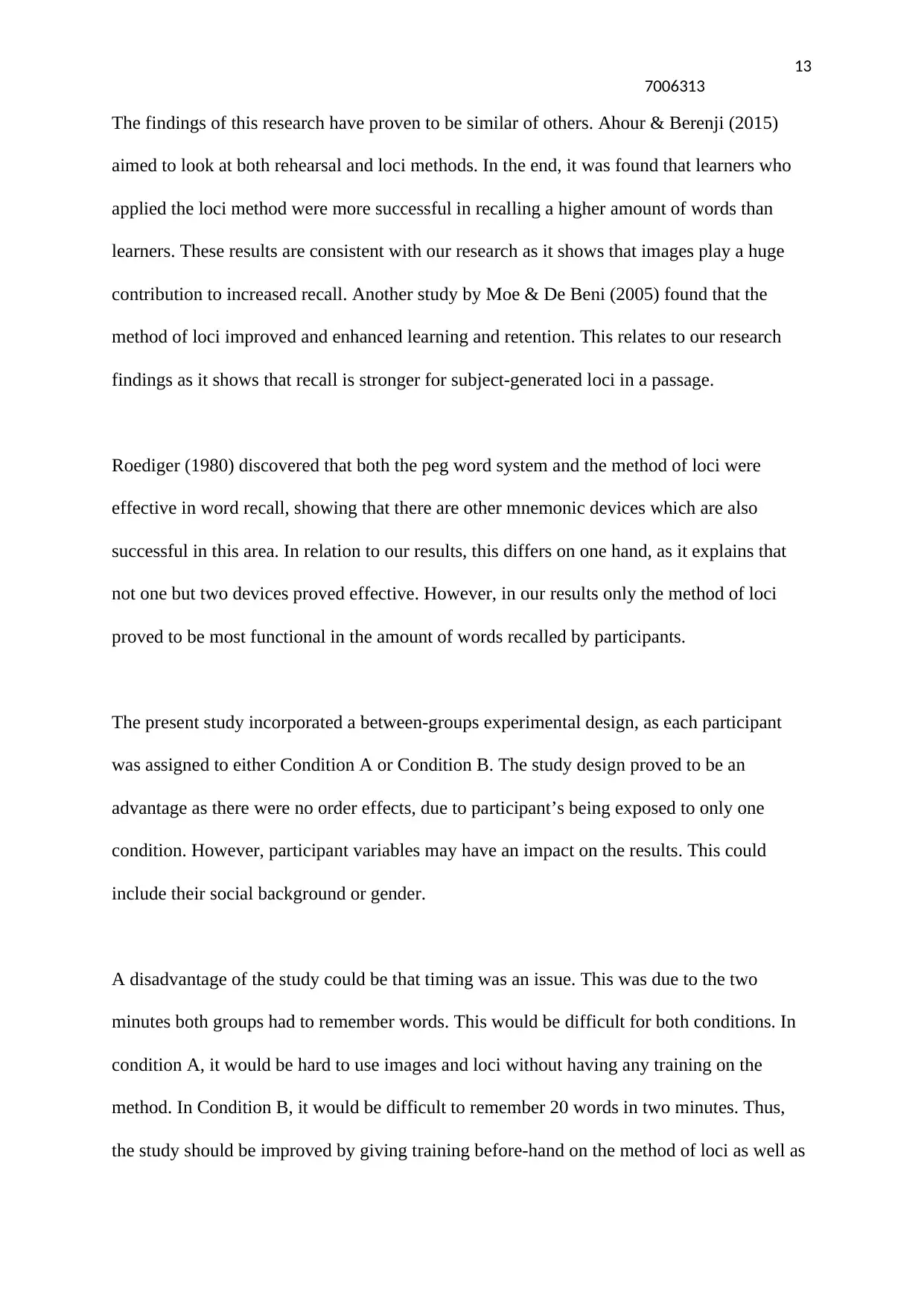
7006313
The findings of this research have proven to be similar of others. Ahour & Berenji (2015)
aimed to look at both rehearsal and loci methods. In the end, it was found that learners who
applied the loci method were more successful in recalling a higher amount of words than
learners. These results are consistent with our research as it shows that images play a huge
contribution to increased recall. Another study by Moe & De Beni (2005) found that the
method of loci improved and enhanced learning and retention. This relates to our research
findings as it shows that recall is stronger for subject-generated loci in a passage.
Roediger (1980) discovered that both the peg word system and the method of loci were
effective in word recall, showing that there are other mnemonic devices which are also
successful in this area. In relation to our results, this differs on one hand, as it explains that
not one but two devices proved effective. However, in our results only the method of loci
proved to be most functional in the amount of words recalled by participants.
The present study incorporated a between-groups experimental design, as each participant
was assigned to either Condition A or Condition B. The study design proved to be an
advantage as there were no order effects, due to participant’s being exposed to only one
condition. However, participant variables may have an impact on the results. This could
include their social background or gender.
A disadvantage of the study could be that timing was an issue. This was due to the two
minutes both groups had to remember words. This would be difficult for both conditions. In
condition A, it would be hard to use images and loci without having any training on the
method. In Condition B, it would be difficult to remember 20 words in two minutes. Thus,
the study should be improved by giving training before-hand on the method of loci as well as
13
The findings of this research have proven to be similar of others. Ahour & Berenji (2015)
aimed to look at both rehearsal and loci methods. In the end, it was found that learners who
applied the loci method were more successful in recalling a higher amount of words than
learners. These results are consistent with our research as it shows that images play a huge
contribution to increased recall. Another study by Moe & De Beni (2005) found that the
method of loci improved and enhanced learning and retention. This relates to our research
findings as it shows that recall is stronger for subject-generated loci in a passage.
Roediger (1980) discovered that both the peg word system and the method of loci were
effective in word recall, showing that there are other mnemonic devices which are also
successful in this area. In relation to our results, this differs on one hand, as it explains that
not one but two devices proved effective. However, in our results only the method of loci
proved to be most functional in the amount of words recalled by participants.
The present study incorporated a between-groups experimental design, as each participant
was assigned to either Condition A or Condition B. The study design proved to be an
advantage as there were no order effects, due to participant’s being exposed to only one
condition. However, participant variables may have an impact on the results. This could
include their social background or gender.
A disadvantage of the study could be that timing was an issue. This was due to the two
minutes both groups had to remember words. This would be difficult for both conditions. In
condition A, it would be hard to use images and loci without having any training on the
method. In Condition B, it would be difficult to remember 20 words in two minutes. Thus,
the study should be improved by giving training before-hand on the method of loci as well as
13
Paraphrase This Document
Need a fresh take? Get an instant paraphrase of this document with our AI Paraphraser
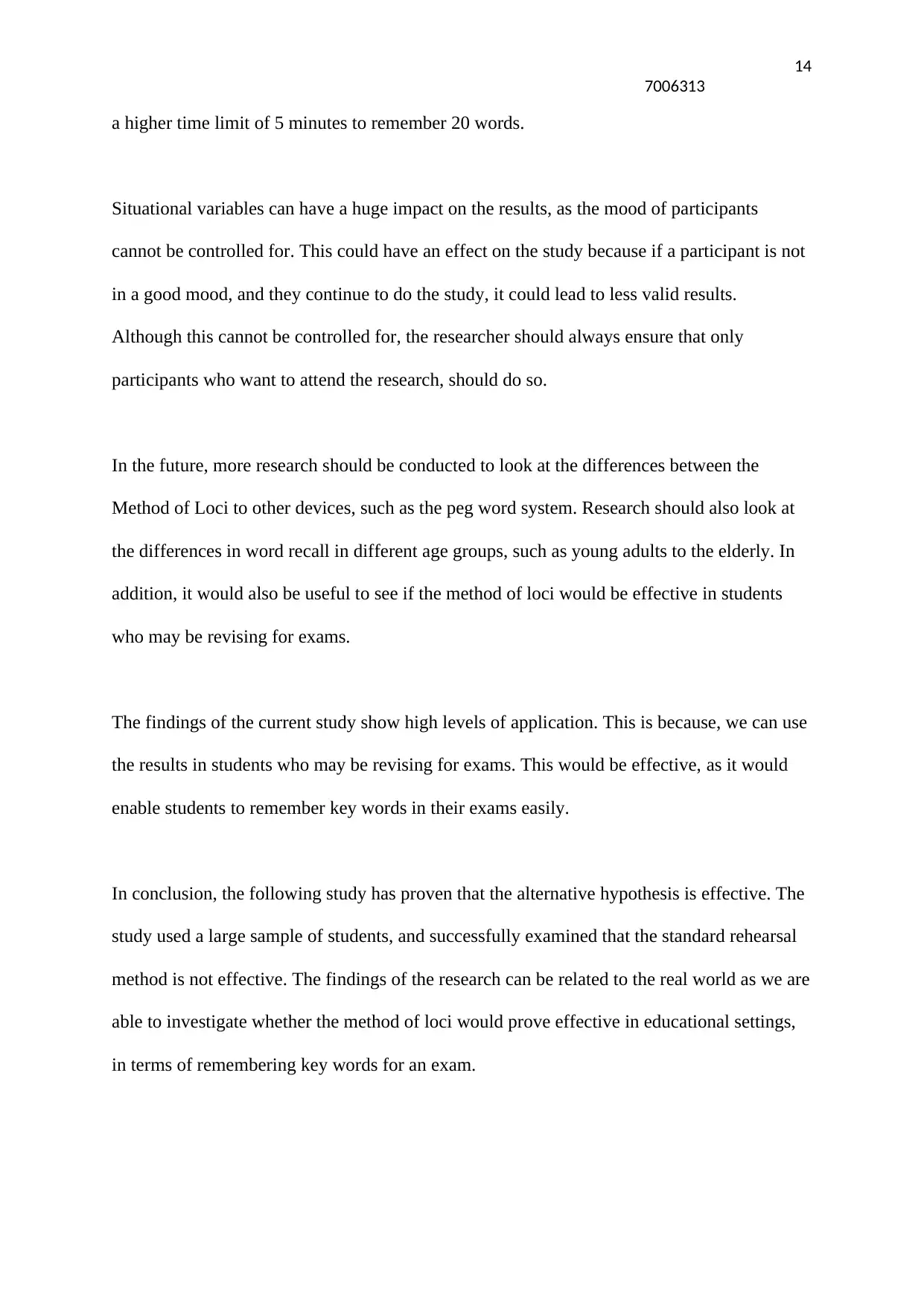
7006313
a higher time limit of 5 minutes to remember 20 words.
Situational variables can have a huge impact on the results, as the mood of participants
cannot be controlled for. This could have an effect on the study because if a participant is not
in a good mood, and they continue to do the study, it could lead to less valid results.
Although this cannot be controlled for, the researcher should always ensure that only
participants who want to attend the research, should do so.
In the future, more research should be conducted to look at the differences between the
Method of Loci to other devices, such as the peg word system. Research should also look at
the differences in word recall in different age groups, such as young adults to the elderly. In
addition, it would also be useful to see if the method of loci would be effective in students
who may be revising for exams.
The findings of the current study show high levels of application. This is because, we can use
the results in students who may be revising for exams. This would be effective, as it would
enable students to remember key words in their exams easily.
In conclusion, the following study has proven that the alternative hypothesis is effective. The
study used a large sample of students, and successfully examined that the standard rehearsal
method is not effective. The findings of the research can be related to the real world as we are
able to investigate whether the method of loci would prove effective in educational settings,
in terms of remembering key words for an exam.
14
a higher time limit of 5 minutes to remember 20 words.
Situational variables can have a huge impact on the results, as the mood of participants
cannot be controlled for. This could have an effect on the study because if a participant is not
in a good mood, and they continue to do the study, it could lead to less valid results.
Although this cannot be controlled for, the researcher should always ensure that only
participants who want to attend the research, should do so.
In the future, more research should be conducted to look at the differences between the
Method of Loci to other devices, such as the peg word system. Research should also look at
the differences in word recall in different age groups, such as young adults to the elderly. In
addition, it would also be useful to see if the method of loci would be effective in students
who may be revising for exams.
The findings of the current study show high levels of application. This is because, we can use
the results in students who may be revising for exams. This would be effective, as it would
enable students to remember key words in their exams easily.
In conclusion, the following study has proven that the alternative hypothesis is effective. The
study used a large sample of students, and successfully examined that the standard rehearsal
method is not effective. The findings of the research can be related to the real world as we are
able to investigate whether the method of loci would prove effective in educational settings,
in terms of remembering key words for an exam.
14
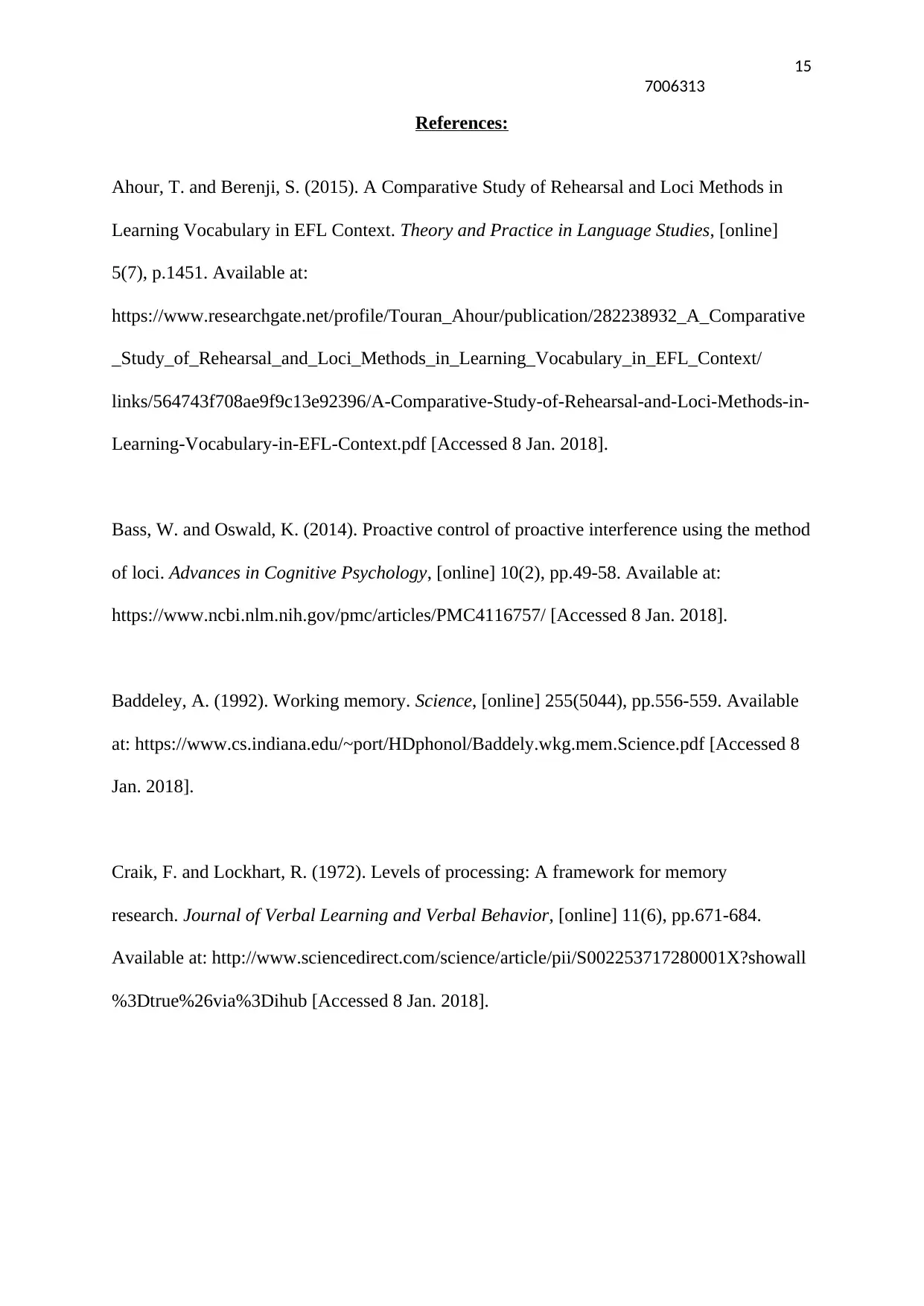
7006313
References:
Ahour, T. and Berenji, S. (2015). A Comparative Study of Rehearsal and Loci Methods in
Learning Vocabulary in EFL Context. Theory and Practice in Language Studies, [online]
5(7), p.1451. Available at:
https://www.researchgate.net/profile/Touran_Ahour/publication/282238932_A_Comparative
_Study_of_Rehearsal_and_Loci_Methods_in_Learning_Vocabulary_in_EFL_Context/
links/564743f708ae9f9c13e92396/A-Comparative-Study-of-Rehearsal-and-Loci-Methods-in-
Learning-Vocabulary-in-EFL-Context.pdf [Accessed 8 Jan. 2018].
Bass, W. and Oswald, K. (2014). Proactive control of proactive interference using the method
of loci. Advances in Cognitive Psychology, [online] 10(2), pp.49-58. Available at:
https://www.ncbi.nlm.nih.gov/pmc/articles/PMC4116757/ [Accessed 8 Jan. 2018].
Baddeley, A. (1992). Working memory. Science, [online] 255(5044), pp.556-559. Available
at: https://www.cs.indiana.edu/~port/HDphonol/Baddely.wkg.mem.Science.pdf [Accessed 8
Jan. 2018].
Craik, F. and Lockhart, R. (1972). Levels of processing: A framework for memory
research. Journal of Verbal Learning and Verbal Behavior, [online] 11(6), pp.671-684.
Available at: http://www.sciencedirect.com/science/article/pii/S002253717280001X?showall
%3Dtrue%26via%3Dihub [Accessed 8 Jan. 2018].
15
References:
Ahour, T. and Berenji, S. (2015). A Comparative Study of Rehearsal and Loci Methods in
Learning Vocabulary in EFL Context. Theory and Practice in Language Studies, [online]
5(7), p.1451. Available at:
https://www.researchgate.net/profile/Touran_Ahour/publication/282238932_A_Comparative
_Study_of_Rehearsal_and_Loci_Methods_in_Learning_Vocabulary_in_EFL_Context/
links/564743f708ae9f9c13e92396/A-Comparative-Study-of-Rehearsal-and-Loci-Methods-in-
Learning-Vocabulary-in-EFL-Context.pdf [Accessed 8 Jan. 2018].
Bass, W. and Oswald, K. (2014). Proactive control of proactive interference using the method
of loci. Advances in Cognitive Psychology, [online] 10(2), pp.49-58. Available at:
https://www.ncbi.nlm.nih.gov/pmc/articles/PMC4116757/ [Accessed 8 Jan. 2018].
Baddeley, A. (1992). Working memory. Science, [online] 255(5044), pp.556-559. Available
at: https://www.cs.indiana.edu/~port/HDphonol/Baddely.wkg.mem.Science.pdf [Accessed 8
Jan. 2018].
Craik, F. and Lockhart, R. (1972). Levels of processing: A framework for memory
research. Journal of Verbal Learning and Verbal Behavior, [online] 11(6), pp.671-684.
Available at: http://www.sciencedirect.com/science/article/pii/S002253717280001X?showall
%3Dtrue%26via%3Dihub [Accessed 8 Jan. 2018].
15

7006313
Craik, F. and Tulving, E. (1975). Depth of processing and the retention of words in episodic
memory. Journal of Experimental Psychology: General, [online] 104(3), pp.268-294.
Available at: http://alicekim.ca/CraikTulving1975.pdf [Accessed 8 Jan. 2018].
Dossani, R., Missios, S. and Nanda, A. (2015). The Legacy of Henry Molaison (1926–2008)
and the Impact of His Bilateral Mesial Temporal Lobe Surgery on the Study of Human
Memory. World Neurosurgery, [online] 84(4), pp.1127-1135. Available at:
http://www.sciencedirect.com/science/article/pii/S1878875015004337 [Accessed 8 Jan.
2018].
Goldstein, E. (2014). Cognitive Psychology: Connecting Mind, Research and Everyday
Experience. 4th ed. Stamford: Cengage Learning, pp.121-145.
Healy, A. and McNamara, D. (1996). VERBAL LEARNING AND MEMORY: Does the
Modal Model Still Work? Annual Review of Psychology, [online] 47(1), pp.143-172.
Available at: http://www.annualreviews.org/doi/pdf/10.1146/annurev.psych.47.1.143
[Accessed 8 Jan. 2018].
Hill, R., Allen, C. and McWhorter, P. (1991). Stories as a mnemonic aid for older learners.
Psychology and Aging, [online] 6(3), pp.484-486. Available at:
http://psycnet.apa.org/record/1992-01147-001 [Accessed 8 Jan. 2018].
16
Craik, F. and Tulving, E. (1975). Depth of processing and the retention of words in episodic
memory. Journal of Experimental Psychology: General, [online] 104(3), pp.268-294.
Available at: http://alicekim.ca/CraikTulving1975.pdf [Accessed 8 Jan. 2018].
Dossani, R., Missios, S. and Nanda, A. (2015). The Legacy of Henry Molaison (1926–2008)
and the Impact of His Bilateral Mesial Temporal Lobe Surgery on the Study of Human
Memory. World Neurosurgery, [online] 84(4), pp.1127-1135. Available at:
http://www.sciencedirect.com/science/article/pii/S1878875015004337 [Accessed 8 Jan.
2018].
Goldstein, E. (2014). Cognitive Psychology: Connecting Mind, Research and Everyday
Experience. 4th ed. Stamford: Cengage Learning, pp.121-145.
Healy, A. and McNamara, D. (1996). VERBAL LEARNING AND MEMORY: Does the
Modal Model Still Work? Annual Review of Psychology, [online] 47(1), pp.143-172.
Available at: http://www.annualreviews.org/doi/pdf/10.1146/annurev.psych.47.1.143
[Accessed 8 Jan. 2018].
Hill, R., Allen, C. and McWhorter, P. (1991). Stories as a mnemonic aid for older learners.
Psychology and Aging, [online] 6(3), pp.484-486. Available at:
http://psycnet.apa.org/record/1992-01147-001 [Accessed 8 Jan. 2018].
16
Secure Best Marks with AI Grader
Need help grading? Try our AI Grader for instant feedback on your assignments.
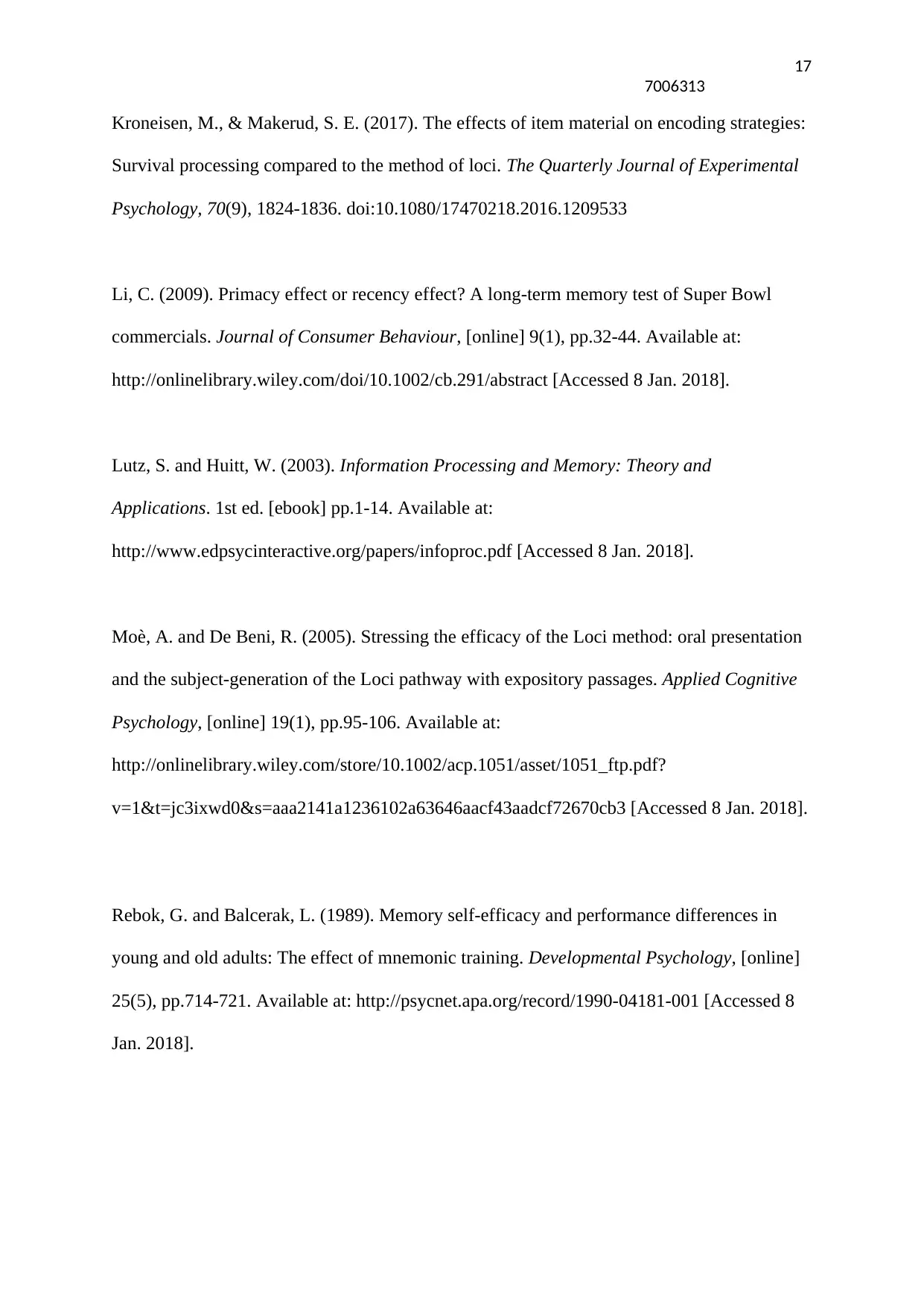
7006313
Kroneisen, M., & Makerud, S. E. (2017). The effects of item material on encoding strategies:
Survival processing compared to the method of loci. The Quarterly Journal of Experimental
Psychology, 70(9), 1824-1836. doi:10.1080/17470218.2016.1209533
Li, C. (2009). Primacy effect or recency effect? A long-term memory test of Super Bowl
commercials. Journal of Consumer Behaviour, [online] 9(1), pp.32-44. Available at:
http://onlinelibrary.wiley.com/doi/10.1002/cb.291/abstract [Accessed 8 Jan. 2018].
Lutz, S. and Huitt, W. (2003). Information Processing and Memory: Theory and
Applications. 1st ed. [ebook] pp.1-14. Available at:
http://www.edpsycinteractive.org/papers/infoproc.pdf [Accessed 8 Jan. 2018].
Moè, A. and De Beni, R. (2005). Stressing the efficacy of the Loci method: oral presentation
and the subject-generation of the Loci pathway with expository passages. Applied Cognitive
Psychology, [online] 19(1), pp.95-106. Available at:
http://onlinelibrary.wiley.com/store/10.1002/acp.1051/asset/1051_ftp.pdf?
v=1&t=jc3ixwd0&s=aaa2141a1236102a63646aacf43aadcf72670cb3 [Accessed 8 Jan. 2018].
Rebok, G. and Balcerak, L. (1989). Memory self-efficacy and performance differences in
young and old adults: The effect of mnemonic training. Developmental Psychology, [online]
25(5), pp.714-721. Available at: http://psycnet.apa.org/record/1990-04181-001 [Accessed 8
Jan. 2018].
17
Kroneisen, M., & Makerud, S. E. (2017). The effects of item material on encoding strategies:
Survival processing compared to the method of loci. The Quarterly Journal of Experimental
Psychology, 70(9), 1824-1836. doi:10.1080/17470218.2016.1209533
Li, C. (2009). Primacy effect or recency effect? A long-term memory test of Super Bowl
commercials. Journal of Consumer Behaviour, [online] 9(1), pp.32-44. Available at:
http://onlinelibrary.wiley.com/doi/10.1002/cb.291/abstract [Accessed 8 Jan. 2018].
Lutz, S. and Huitt, W. (2003). Information Processing and Memory: Theory and
Applications. 1st ed. [ebook] pp.1-14. Available at:
http://www.edpsycinteractive.org/papers/infoproc.pdf [Accessed 8 Jan. 2018].
Moè, A. and De Beni, R. (2005). Stressing the efficacy of the Loci method: oral presentation
and the subject-generation of the Loci pathway with expository passages. Applied Cognitive
Psychology, [online] 19(1), pp.95-106. Available at:
http://onlinelibrary.wiley.com/store/10.1002/acp.1051/asset/1051_ftp.pdf?
v=1&t=jc3ixwd0&s=aaa2141a1236102a63646aacf43aadcf72670cb3 [Accessed 8 Jan. 2018].
Rebok, G. and Balcerak, L. (1989). Memory self-efficacy and performance differences in
young and old adults: The effect of mnemonic training. Developmental Psychology, [online]
25(5), pp.714-721. Available at: http://psycnet.apa.org/record/1990-04181-001 [Accessed 8
Jan. 2018].
17
1 out of 17
Your All-in-One AI-Powered Toolkit for Academic Success.
+13062052269
info@desklib.com
Available 24*7 on WhatsApp / Email
![[object Object]](/_next/static/media/star-bottom.7253800d.svg)
Unlock your academic potential
© 2024 | Zucol Services PVT LTD | All rights reserved.

